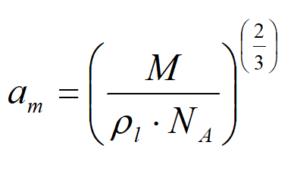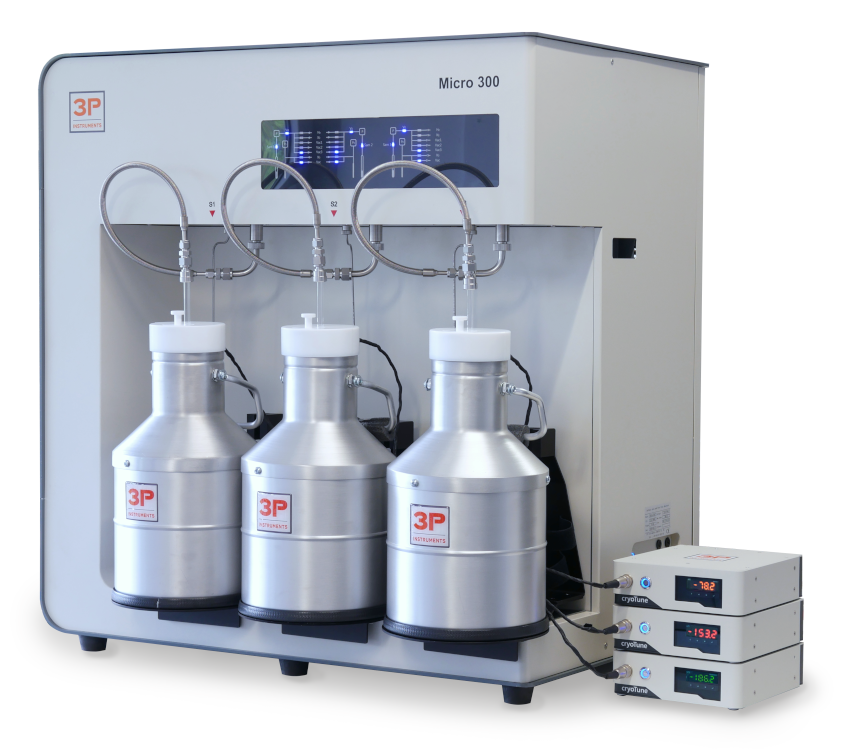The cryoTune series opens new horizons for gas sorption measurements. It offers the possibility for almost all volumetric sorption instruments, no matter if newer or older production dates, to follow the ISO 9277 /1/ for BET measurements as well as the IUPAC recommendation for micropore characterization /2/. Both publications explain that noble gases, unlike the nitrogen molecule, have a spherical symmetry and no quadrupole moment. Therefore, the adsorption of noble gas atoms results from a pure van-der-Waals interaction and the atoms do not have different orientations on the adsorbent surface.
The cryoTune series requires only liquid nitrogen for cooling and allows a temperature range of 77 – 323 K. With the cryoTune 87, e.g. measurements for the determination of specific surfaces at Ar 87 K or Kr 120 K can be performed to obtain scientifically correct results. The cryoTune also allows the sorption of various other measuring gases at their boiling point or other arbitrary temperatures. Due to this unique flexibility, pure gas isotherms of methane, ethane, propane, n-butane, oxygen, carbon dioxide, SF6, etc. can be measured and thermodynamic calculations can be performed at different temperatures. The following table shows the different adsorptives, their boiling termperatures, the density of the liquid adsorptive ρLiquid, the critical diameter of the atom/molecule, the space requirement for one adsorbate atom or molecule am, the saturation pressure p0 and the non-ideality factor of the real gases Fni.
| Adsorptive | Boiling point T / K | ρLiquid / g cm-3 | Critical diameter of atom/molecule / nm /3/ | am for BET surface from ρLiquid *4 / nm2 | p0 / kPa | Non-ideality factor Fni of the adsorptive *3 |
Ar | 87 | 1.39 | 0.34 | 0.143 | 101 | 4.27·10-5 |
Kr | 120 | 2.41 | 0.36 | 0.163 | 101 | 3.83·10-5 |
Xe | 165 | 2.94 | 0.41 | 0.192 | 101 | 3.71·10-5 |
SF6 | 209 | 1.91 | 0.67 | 0.276 | 101 | 3.87·10-5 |
CH4 | 112 | 0.42 | 0.40 | 0.174 | 101 | 4.26·10-5 |
Ethane | 184 | 0.54 | 0.44 | 0.223 | 101 | 3.86·10-5 |
Propane | 231 | 0.58 | 0.49 | 0.275 | 101 | 3.93·10-5 |
n-Butane | 273 | 0.60 | 0.49 | 0.322 | 101 | 4.05·10-5 |
| O2 | 90 | 1.14 | 0.28 | 0.141 | 101 | 4.09·10-5 |
N2 | 77 | 0.81 | 0.30 | 0.162 | 101 | 5.21·10-5 |
| CO2 | 195*1 | 1.26 | 0.28 | 0.164*2 | 188*2 | 2.09·10-5 |
| Ethene | 196 | 0.58 | 0.39 | 0.203 | 101 | 3.71·10-5 |
| CO | 82 | 0.94 | 0.37 | 0.147 | 101 | 5.11·10-5 |
| NH3 | 240 | 0.70 | 0.29 | 0.128 | 101 | 4.17·10-5 |
| iso-Butane | 261 | 0.59 | 0.51 | 0.325 | 101 | 1.71·10-5 |
*1…sublimation point
*2…p0 and ρLiquid of the undercooled liquid
*3…mean value from van der Waals- und Bethelot equations
*4…calculated according to: 



Although a cryoTune can work as stand-alone without a PC, it is delivered with software that can display and record the real time temperature. The cryoTune series consists of three versions, which can be purchased individually or as a package. All models are connected to a measuring station of your sorption device. If you have a multi-station device in use, it is possible to connect several cryoTunes.
The cryoTune 77 is an option for sorption experiments at 77.35 – 78 K with a temperature control accuracy of better than 0.004 K for realizing temperature-stable, isothermal measurements with nitrogen and other gases. Particularly useful for krypton, argon or methane when saturation vapor pressure cannot be measured during measurement and accordingly cannot be corrected. The cryoTune 77 significantly increases measurement accuracy and reproducibility of measurements close to 77 K, due to the exact temperature control no p0 correction is necessary.
The cryoTune 87 covers the temperature range 82 – 135 K, making the cryoTune 87 the standard option for Ar 87 K measurements for surface and pore analysis recommended in ISO 9277 and IUPAC recommendation of 2015.
The cryoTune 195 is the cryoTune version for isotherm measurements in the range of 180 – 323 K. This allows CO2 measurements in particular, but also measurements of other adsorptives such as ethane or propane at their boiling temperatures. For such measurements you neither need a refrigeration thermostat, nor a dry ice refrigeration mixture nor a double-walled additional Dewar. Among others, the cryoTune 195 enables the following CO2 measurement possibilities:
The cryoTune 120 completes the cryoTune series and enables long-term measurements especially in the range 115 K (boiling temperature of krypton) over 165 K (boiling temperature of xenon) up to 230 K. The combination cryoTune 87 and 120 thus allows the use of three noble gases at their boiling temperature: Argon 87 K, Krypton 120 K and Xenon 165 K, as well as a multitude of other measurement possibilities with Ar, O2, methane, ethane or propane.
If you are interested in further information for purchase, rental, test or contract measurements for the IUPAC-compliant micropore analysis (Ar 87 K) please click here.
/1/ ISO 9277:2010: Determination of the specific surface area of solids by gas adsorption – BET method
/2/ IUPAC recommendation, Pure Appl. Chem. 87 (9-10), 1051-1069 (2015); pdf-Download
/3/ Kast, W.: Adsorption aus der Gasphase, Verlag Chemie, Weinheim, 1988
/5/ https://www.3p-instruments.com/de/cryotune-for-bet-surfaces-with-argon-87-k-with-nitrogen-cooling/
/6/ Fröba et al., Partikelwelt 17, “Die Charakterisierung von porösen Hybrid- und Funktionsmaterialien im Rahmen der „Energieproblematik”” p. 17 ff. [available only in German]
/7/ D. Klank, PARTICLE WORLD 19, “Why do we measure surfaces and pores with argon and krypton gas adsorption much more often in future?” S. 26 – 29
/8/ D. Klank, C. Reichenbach, Chem. Ing. Tech., 2019, 91 (7), 934 – 935, https://doi.org/10.1002/cite.201970071 [available only in German]
/9/ D. Klank, C. Reichenbach, C. Lüttmann, Laborpraxis, August 2019, 30 – 32, https://www.laborpraxis.vogel.de/ist-die-bet-methode-zu-oberflaechlich-a-852355/ [available only in German]
/10/ C. Reichenbach, D. Klank, Chem. Ing. Tech. 2019, 91 (11), 1504–1505, https://doi.org/10.1002/cite.201971101 [available only in German]
/11/ Particle World 21; p. 21 – 24; “Application of substance data for sorption analyses in adsorptives at various temperatures”
/12/ D. Klank, C. Blum, D. Schneider, Chem. Ing. Tech. 2020, 92 (12), 1871–1872, https://doi.org/10.1002/cite.202071205 [available only in German]
| 3P micro series | Up to 3 stations, especially suitable for micropore analysis |
| 3P meso series | Up to 4 stations, especially suitable for mesopore analysis |
| 3P sync series | Up to 4 stations in one dewar, mesopore analysis with minimal space consumption |